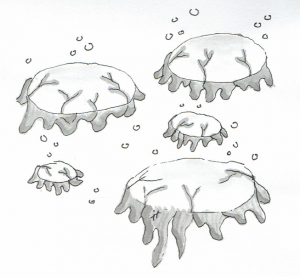Difference between revisions of "Sea Bladder"
From World of Entorais Wiki
Jump to navigationJump to search (applied template) |
m (content) |
||
| Line 1: | Line 1: | ||
[[File:Sea_bladder.png|thumb|right|200x|Sea Bladder]] | [[File:Sea_bladder.png|thumb|right|200x|Sea Bladder]] | ||
==Description== | ==Description== | ||
;Common Names: | ;Common Names:Sea Bladder | ||
;Classification: | ;Classification:Algae | ||
Sea Bladders are colonies of highly specialized marine algae, which form a membranous sac that fills with buoyant gas and fresh water as the colony processes sunlight and filter feeds on ocean micro nutrients. The gas contained in these bladders is poisonous, reeks of rotten eggs, and is highly flammable, burning with an intense blue flame. Sufficient reserves of the gas can cause these colonies to reach the surface of the oceans, where they are sometimes mistaken for large marine animals, or jellyfish. The liquid contained in the bladders is one of the only sources of potable water in the open salt water. | |||
==Ecology== | ==Ecology== | ||
;Rarity: | ;Rarity:Uncommon | ||
;Distribution: | ;Distribution:Tropical to Temperate saltwater | ||
;Life Cycle: | ;Life Cycle:As the colonies grow they can be ruptured or fragmented by wave action, or feeding animals fragments will survive and form new colonies. the bouyancy produced by the gases, and ballast provided by the fresh water help keep the sea bladders at an optimal depth for photosynthesis. | ||
==Uses== | ==Uses== | ||
;Cultivation: | ;Cultivation:none | ||
;Culinary: | ;Culinary:none | ||
;Medicinal: | ;Medicinal:none | ||
;Other: | ;Other:source of fresh water at sea, source of flammable gas | ||
==Culture== | ==Culture== | ||
Revision as of 22:24, 4 February 2019
Description
- Common Names
- Sea Bladder
- Classification
- Algae
Sea Bladders are colonies of highly specialized marine algae, which form a membranous sac that fills with buoyant gas and fresh water as the colony processes sunlight and filter feeds on ocean micro nutrients. The gas contained in these bladders is poisonous, reeks of rotten eggs, and is highly flammable, burning with an intense blue flame. Sufficient reserves of the gas can cause these colonies to reach the surface of the oceans, where they are sometimes mistaken for large marine animals, or jellyfish. The liquid contained in the bladders is one of the only sources of potable water in the open salt water.
Ecology
- Rarity
- Uncommon
- Distribution
- Tropical to Temperate saltwater
- Life Cycle
- As the colonies grow they can be ruptured or fragmented by wave action, or feeding animals fragments will survive and form new colonies. the bouyancy produced by the gases, and ballast provided by the fresh water help keep the sea bladders at an optimal depth for photosynthesis.
Uses
- Cultivation
- none
- Culinary
- none
- Medicinal
- none
- Other
- source of fresh water at sea, source of flammable gas
